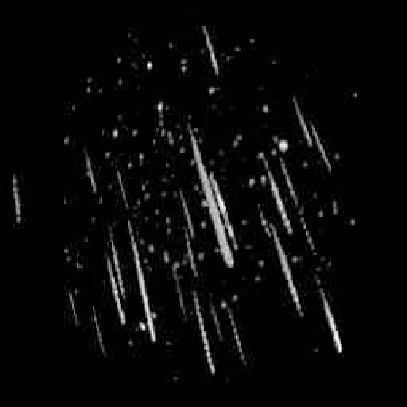Astronomy Picture of the Day
Discover the cosmos!
Each day a different image or photograph of our fascinating universe is
featured, along with a brief explanation written by a professional
astronomer.
August 9, 1996

The Perseid Meteor Shower
Credit:
Sirko Molau,
IMO,
Archenhold-Sternwarte
Explanation:
From a radiant point in the constellation of Perseus, Comet Swift-Tuttle
presents -- The Perseid Meteor Shower -- coming to your night sky this weekend!
A bookish E. C. Herrick of New Haven, Connecticut correctly suspected in 1837 that
this meteor shower was an annual event.
Indeed it is now known to be a
regular August shower caused by the
yearly passage of the Earth through the orbiting debri left behind
by periodic comet Swift-Tuttle.
Since the bits of comet debri are
moving along parallel orbits, on entering the atmosphere they leave
fiery trails which appear to originate
from a common radiant point
in the sky, in this case in the
constellation of Perseus.
Dramatically illustrated in this
composite video image made using
MOVIE,
meteors from the 1994 Perseids
streak across the sky framed by the three bright stars of the
asterism known as the "Summer Triangle".
The image shows
bright Perseids recorded that year
from August 9 through 14. Here the trails appear nearly parallel as the camera
was centered on the sky about 90 degrees from the radiant point.
This year,
European and North American observers should be able
to view the shower near its maximum, about 90 meteors per hour,
early Monday morning August 12, but the shower should be enjoyable
on clear weekend nights (August 10,11) as well.
After midnight is generally the best time for viewing.
What's the best way to enjoy a meteor shower?
Get a warm jacket and a comfortable lawnchair ...
go outside and look up.
Tomorrow's picture: Unusual Spiral Galaxy M66
| Archive
| Index
| Search
| Glossary
| Education
| About APOD |




Authors & editors:
Robert Nemiroff
(MTU) &
Jerry
Bonnell (USRA).
NASA Technical Rep.:
Sherri
Calvo.
Specific rights apply.
A service of:
LHEA
at
NASA/
GSFC




